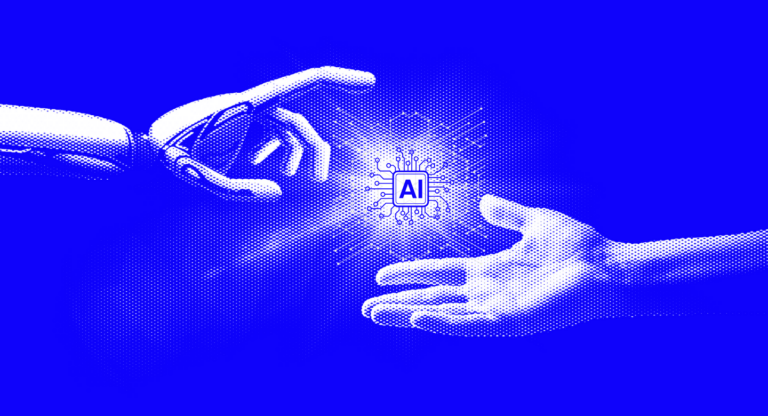Organizations face unprecedented challenges in the digital age to remain competitive and relevant. They must adapt and transform their operations to keep pace with the ever-changing business landscape.
One of the most significant transformations today is the shift from traditional business practices to artificial intelligence (AI) driven operations.
This article will explore the benefits of transforming your organization from traditional to AI-driven and the steps involved in making this transformation.
Introduction
In recent years, the use of AI in business has gained widespread attention. AI has the potential to revolutionize how companies operate, from improving efficiency and productivity to enhancing customer experience. The transition from traditional business practices to AI-driven operations can be challenging, but the benefits are undeniable.
What is AI-Driven Transformation?
AI-driven transformation integrates artificial intelligence into an organization’s operations to enhance performance. This involves using machine learning algorithms to analyze data, automate tasks, and make informed decisions.
AI can help businesses to improve efficiency, reduce costs, and improve customer satisfaction. AI-driven transformation is not just about adopting new technology. It requires a fundamental shift in how an organization operates and thinks about its operations.
Benefits of AI-Driven Transformation
- Enhanced Efficiency: AI can help organizations to automate tasks and improve efficiency. This means that employees can focus on more critical tasks, leading to higher productivity and better results.
- Improved Decision-Making: AI can analyze vast data and provide insights to inform decision-making. This means organizations can make informed decisions quickly, leading to better outcomes.
- Cost Reduction: AI can help organizations to reduce costs by automating tasks and optimizing processes. This means that organizations can operate more efficiently and reduce the need for manual labor.
- Better Customer Experience: AI can help organizations to provide better customer experiences by analyzing customer data and providing personalized recommendations. This means that organizations can improve customer satisfaction and loyalty.
Steps to Transform Your Organization
1. Identify Business Goals
Identifying your business goals is the first step in transforming your organization with AI. This involves understanding what you want to achieve through AI and how it can help you to improve your operations. For example, you can improve customer satisfaction, reduce costs, or increase revenue.
2. Assess Data Availability
The next step is to assess the availability of your data. You need to understand your data, where it is stored, and how it can be accessed. This will help you identify gaps in your data and determine additional data you need to collect.
3. Develop a Data Strategy
Once you have assessed your data availability, you must develop a data strategy. This involves identifying the data sources you will use, the data collection methods, and how you will store and manage your data. You may also need to consider data privacy and security.
4. Select Appropriate AI Tools
The next step is to select the appropriate AI tools for your organization. Many AI tools are available, including machine learning, natural language processing, and computer vision. You need to determine which tools will help you to achieve your business goals.
For example, you may use chatbots or virtual assistants to interact with customers and provide personalized support to improve customer service. To optimize your supply chain, you may use predictive analytics to forecast demand and optimize inventory levels.
5. Implement and Test AI Solutions
Once you have selected your AI tools, you must implement and test your AI solutions. This involves integrating AI into your existing operations and testing its effectiveness. You may need to make adjustments to your AI solutions based on the results of your testing.
6. Monitor and Evaluate Results
The final step is to monitor and evaluate the results of your AI solutions. This involves tracking key performance indicators (KPIs) to measure the success of your AI implementation. You may need to make additional adjustments based on your results to ensure your AI solutions meet your business goals.
Examples of AI Tools and Use Cases
Here are some examples of AI tools and use cases that can help you to transform your organization:
Machine Learning
Machine learning is a subset of AI that involves training computers to learn from data and make predictions or decisions without being explicitly programmed. It is one of the most popular and widely used AI tools. Here are some examples of how machine learning can be used to transform organizations:
- Predictive maintenance: Based on sensor data and other sources, machine learning can predict when a machine will fail. This can help organizations to perform maintenance before a failure occurs. For example, a manufacturing company may use machine learning to predict when a machine will fail, reducing downtime and maintenance costs.
- Fraud detection: Machine learning can identify fraudulent activities by analyzing large volumes of data. This can help organizations to detect and prevent fraud before it occurs. For example, a financial institution may use machine learning to identify patterns of fraudulent behavior in credit card transactions.
- Personalized recommendations: Machine learning can provide customized customer recommendations based on their preferences and behavior. This can help organizations to improve customer satisfaction and increase sales. For example, an e-commerce company may use machine learning to recommend products to customers based on their purchase history and browsing behavior.
Natural Language Processing
Natural language processing (NLP) is a subset of AI that involves analyzing and understanding human language. It can be used to analyze text, speech, and other forms of natural language data. Here are some examples of how NLP can be used to transform organizations:
- Chatbots: NLP can be used to create chatbots that can interact with customers and provide personalized support. This can help organizations to improve customer service and reduce support costs. For example, a healthcare company may use a chatbot to provide personalized medical advice to patients.
- Sentiment analysis: NLP can analyze customer feedback and sentiment, providing insights to inform business decisions. This can help organizations improve their products and services based on customer feedback. For example, a restaurant chain may use sentiment analysis to analyze customer reviews and identify areas for improvement.
- Voice recognition: NLP can recognize and interpret human speech, enabling voice-enabled applications and devices. This can help organizations to improve accessibility and convenience for their customers. For example, a home automation company may use voice recognition to enable customers to control their home devices using voice commands.
Computer Vision
Computer vision is a subset of AI that involves training computers to interpret and analyze images and videos. It can detect objects, recognize faces, and analyze visual data. Here are some examples of how computer vision can be used to transform organizations:
- Facial recognition: Computer vision can recognize faces, enabling security and authentication applications. This can help organizations to improve security and reduce fraud. For example, a bank may use facial recognition to authenticate customers for online banking transactions.
- Object recognition: Computer vision can detect and recognize objects in images and videos, enabling applications such as autonomous vehicles and quality control. For example, a manufacturing company may use computer vision to detect defects on a production line.
- Quality control: Computer vision can analyze visual data to ensure that products meet quality standards. This can help organizations to reduce waste and improve product quality. For example, a food processing company may use computer vision to ensure its products are packaged correctly and meet quality standards.
By leveraging these and other AI tools, organizations can improve efficiency, reduce costs, make better decisions, and provide better customer experiences. By embracing AI-driven transformation, organizations can stay competitive and thrive in the digital age.
Conclusion
The transition from traditional business practices to AI-driven operations is a significant transformation that requires careful planning and execution. However, the benefits of this transformation are undeniable. AI can help organizations to improve efficiency, reduce costs, make better decisions, and provide better customer experiences. Organizations must identify their business goals, assess data availability, develop a data strategy, select appropriate AI tools, implement and test AI solutions, and monitor and evaluate results to make this transformation. By embracing AI-driven transformation, organizations can stay competitive and thrive in the digital age.
FAQs
What is AI-driven transformation, and why is it important?
AI-driven transformation integrates artificial intelligence into an organization’s operations to enhance performance. It is essential because it can help organizations to improve efficiency, reduce costs, make better decisions, and provide better customer experiences.
How does AI improve efficiency in organizations?
AI can help organizations automate tasks and improve efficiency by analyzing data and providing insights to inform decision-making.
What steps are involved in transforming an organization from traditional to AI-driven operations?
The steps in transforming an organization from traditional to AI-driven operations are identifying business goals, assessing data availability, developing a data strategy, selecting appropriate AI tools, implementing and testing AI solutions, and monitoring and evaluating results.
What are the benefits of AI-driven transformation?
The benefits of AI-driven transformation include enhanced efficiency, improved decision-making, cost reduction, and better customer experience.
What are some challenges organizations may face when transitioning to AI-driven operations?
Some challenges organizations may face when transitioning to AI-driven operations include data availability and quality, selecting the appropriate AI tools, integrating AI into existing processes, and ensuring data privacy and security.
Photo by Joshua Sortino.



